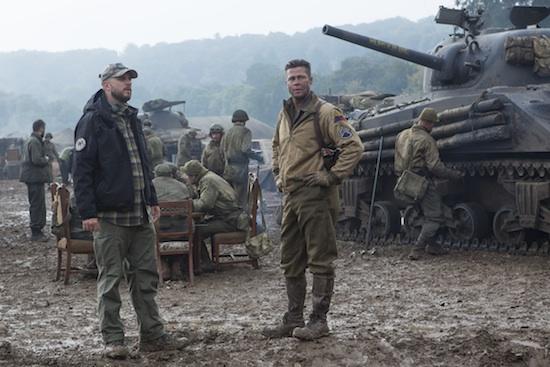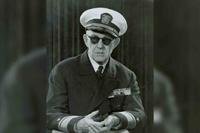
Fury, scheduled for release on November 14, is writer/director David Ayer’s new movie about a U.S. Sherman tank mission behind German lines in April 1945. Brad Pitt plays the tank commander Wardaddy and Shia LaBeouf, Logan Lerman, Michael Peña and Jon Bernthal play the other men in the tank’s crew.
I visited the set of Fury last November at Bovingdon Airfield in Hertfordshire about an hour outside of London. The disused (we were in Britain, that’s what they call it) airfield was built during WWII and the British countryside was standing in for Germany.
On the day we visited, Ayer was filming a tank battle. The actors weren’t on set, but we got a chance to talk with a lot of the crew and the military support team, all of whom were determined to bring an unprecedented level of authenticity to this portrayal of WWII.
%embed1%
Ayer is best known for writing and/or directing a series of films about the LAPD. Training Day, Dark Blue and Street Kings are three of the best bent cop movies ever made. End of Watch is the flip side, a tribute to the day-to-day travails of honest cops. All of the movies have an intense focus on the procedural side of the job. Details matter to Ayer and even his crooked characters have a respect and focus for how they do their jobs.
Ayer also rewrote and directed this year’s Sabotage, with Arnold Schwarzenegger as a corrupt DEA agent trying to figure out who’s killing off the members of his team after a heist. It’s violent and there aren’t any redeeming characters, but Ayer once again captures the camaraderie and work mechanics of law enforcement.
All evidence suggests that Fury is going to be more about the chemistry and workflow inside a tank than it is a story about a mission behind enemy lines. That doesn’t mean the mission isn’t important and that the plot won’t be exciting, but Ayer’s previous work suggests that the plot will probably be a frame he uses to explore how troops dealt with each other and the challenges of their job.
Set visits are complicated. You’re a guest in someone’s workspace and, even though there were at least a hundred crew members on set that day, the people doing the work aren’t always used to being observed and the filmmakers want to keep a lot of things secret until they’ve finished making the movie. That meant no photos on the set and therefore no photos of all the folks we spoke with.

We met Charlie Rotherham and Xander Rawlings, two UK veterans who now run a firm called Solider in Blue. They work as military advisers to film and TV and the company recruits veterans and their families for extras work. Along with fellow veteran David ‘Sting’ Rae, they spent a lot of time with the actors discussing their own combat experiences and even tracking down a 90-year-old vet who could describe his what it was like to serve in a Sherman tank on D-Day.
Rotherham and Rawlings started the company after working as extras on Les Miserables and realizing that almost no one playing a military role as an extra had any actual military experience. They knew a lot of veterans who were looking for work and decided that they could provide military-themed entertainment with extras who actually knew what they were doing and have real experience in following directions. They also try to find work for military families who have a member deployed overseas.
Solider in Blue helped put together tank crews for the battle scenes, finding men who’ve actually served in modern tanks in Afghanistan to make sure the mechanics of moving turrets and firing look as authentic as possible.
Former Navy SEAL Kevin Vance has worked closely with Ayer on End of Watch and Sabotage and put the Fury actors through boot camp (he also served as a military advisor on the video game Medal of Honor: Warfighter). In addition Rae was hired to be on the set full-time to help everyone understand the tight-knit dynamics of a tank crew and how they work together in such close quarters.

David Ayer talked to us about his motivation in making the film.
At the end of the day it's about brotherhood in combat. It's about a love for each other which I think you really only experience in the armed forces.
It’s a bit of a myth that World War II is is a clean war. In respect to the fighting and moral hazards and the quandaries that the servicemen faced, those are the same issues that servicemen face now, that’s just as complex and just as painful and has the same outcome. The fighting and the scars for those men were just as much as what happened Vietnam or Iraq or Afganistan.
Ayer talked about the overwhelmingly positive response from law enforcement to End of Watch and how that response influenced Fury.
After End of Watch I don’t think I could get arrested if I tried. In the Navy, I was in the submarine community and it's all about attention to detail. They beat it into you at boot camp. You know, wrong switch position, wrong valve position on the submarine can sink the boat and that’s not good because everyone is dead.
When you get the details correct, everything else comes from that, and getting the details is also about the interrelationship between people, the characters, the lifestyle. With End of Watch, I wanted to show that law enforcement is not just a gun and a badge, but it's what your wife is telling you, what you come home to and trying to have a relationship in this very strange job.
I feel like World War II movies are often just bad Xeroxes of a bad Xerox. I wanted to go back to the original after action reports, back to the military sources, back to the wartime infantry, and to what the men themselves experienced in their own words and try to understand that.
As a director and a writer, I try to bring that experience to the audience, even though we will never be close to the real thing. You can't experience battle, combat, unless you’ve experienced it. That’s just the bottom line. But I can take the audience into the world of a soldier and combat and let them see what things looked like. It's never looked like this in a war movie, you know?
Everything is about the details. I've gone to great lengths to get the uniforms right, you know the gun leather, all these things. And if you’ve been in the service, that's what drives you nuts when somebody gets it wrong.
If you look at faces of these soldiers today, you look at the face of the soldier in World War II, all the way back to the Civil War, it's the same guys. It's the same seven guys.

We also had a chance to talk with Col. Kevin Farrell, who advised Ayer on the historical aspects of the production. Visiting from California, he happened to be on the set that day and shared his enthusiastic reaction to seeing everything in person for the first time.
I worked with David early on advising the cast. I spent 30 years in uniform, commanded a tank battalion and I have extensive combat experience and a lot of years spent on tanks. So I was asked to provide some insights both from a historical perspective on what it was like to be a tanker in U.S. Army Europe and at the end of the war. I was formally Chief of Military History at West Point at the Military Academy, so I had that academic scholarship background, but I've also had for ten years’ experience in tank battalions and in the platoon, the company, and the battalion level.
One of the things I was asked to do was just to provide some insights about that experience, that background, what it would feel like, what it's like to be inside the tank. I've also helped David in terms of radio communications, the way they would talk on the radio and what the sounds would be.
You can obviously tell that the authentic nature of everything on set is very impressive. One of the things that David has asked for from the beginning is that it be exactly as it was, and I can attest to the fact that it is exactly as it was. If you look at the tanks, you look at the uniforms, and then you look at the way they move on the field was the way they carried themselves. They would be indistinguishable from someone in that period, the way they're on the tanks. Everything is spot-on accurate.
We used the official records of the Second Division, the actual combat logs, the unit histories, and from personal accounts from the battles themselves.
Usually with a movie, people can say, “Oh, they wouldn’t have done that or they got that wrong.” And I will just tell you that what you see here, there won't be any of that. That this is exactly right. Just to see the way that the vehicles are portrayed and the equipment on them and the personal gear, the stowage, the actual equipment they would have been issued, and then the way they would have customized them in the field. It's as it actually was.
There are other some great films about World War II, but, if you think Kelly's Heroes, which is the most famous one in the American Tankers, the movie gets some of it right then some of it's absolutely ridiculous. Even Saving Private Ryan, if you look closely, there are a number of mistakes. There are no mistakes here. It's really that good.
That’s obviously a strong endorsement from someone who actually knows what he’s talking about.
The rest of the day included a tour of the massive prep area for extras. There were hundreds of uniforms (both Allied and Nazi), all of which had been created with painstaking detail, including a German camo pattern that was only introduced at the specific time the movie is set. There won’t be any accidental goofs in the background of a scene. Extras makeup had a wall plastered with historical photographs so the artists can give everyone a proper period look.
Much of the movie takes place inside the tank. We got a chance to see how that’s done. Art Director Gary Jopling gave us tour of the recreated tank, which is slightly larger than the real thing and features removable panels that allowed Ayer to shoot the interior from every angle he wanted. The whole thing sits high up on a rotating platform in a warehouse and the tank interior was festooned with the kind of wartime souvenirs the characters would have collected during their previous combat.
Production designer Andrew Menzie gave a tour of the German town set, a series of facades that absolutely pass for the real thing when you check out the trailer above.
All of this begs a pretty straightforward question about a project that’s so concerned with authenticity: why shoot a movie that’s set in Germany on recreated sets in England?
You could suggest that Bovingdon Airfield has a long history as the set for WWII films (notably The Battle of Britain, Mosquito Squadron and Hanover Street) and even made its James Bond appearance in the flying car scene of The Man With the Golden Gun.

The real reason for the UK shoot might be the set’s proximity to the Bovington Tank Museum (not a misspelling: there seems to be one of those ancient British spelling disputes and the name shows up both way around there). The museum gave Ayer access to the only surviving German Tiger 131 tank that still runs.
We got a rundown from museum curator David Willey, who’s also serving as an advisor on Fury.
The Tiger was captured out in Tunisia in 1943 by a lot called the 48th Royal Tank Regiment and it was brought back to Britain for evaluation. And it was taken apart weirdly at a place that’s now Longcross Studios. It used to be a place called Chobham. But they did all the experimental tank stuff there and they took the Tiger all apart, looked at it, learned as much as they possibly could about it, wrote lots of reports on it, and then in 1951, well after the war, it came down to the tank museum.
It looks complete, but actually when it came to the museum it was still disassembled from its analysis. The original engine, for example, had been chopped up as a teaching aid. So in the 90’s, we got a program going to getting it running again and now it's the only one of six real remaining Tigers left, Tiger I's, and this is the only one that runs. We take it out about three times a year down at the museum and show it off.
We were approached early on by producers of this film and we started talking to them earlier this year. We've lent other tanks to Fury, including the main Sherman.
During the course of those negotiations, we didn’t think we'd ever lend the Tiger, which is such an important vehicle for us. But in the end, as time moved on, we were looking at what they were doing. We went through an awful lot of soul-searching and hoops and big issues to deal with this, insurance issues, all sorts of things, but in the end it seemed a very sensible thing for us to get involved.
And as you’ve seen, they're making a big effort to do with accuracy. And this tank, while being entirely honest, is not gonna run forever, so the more we can get it exposed while it’s still running, the better for us, and the more people will get to see it. So it meets our charitable aims as well.
This tank is a very important bit of heritage, a bit of cultural property. Making sure we're keeping the balance between getting it seen and making sure we're looking after it and making sure we don’t put it at undue risk is very important. So one of the key things we've been doing is making sure we've seen the sides it's gonna be used on, how it's gonna be used. We've gone into fairly close detail about what can and can't be done with the tank, and that’s why we're all up here from the museum is to make damn sure that happens when we don’t put the Tiger into too much risk.
The tank is running an original Maybach wartime engine. If you want to be really nerdy, what's powering that is something called a Maybach HL230 engine. As I said, the one that was actually in the tank when it was captured unfortunately was chopped up as a teaching aid after the war. I mean actually we had a war to win, so you can't forgive them for doing things like that at the time.
Otherwise,what you're looking at now, I'd still go along to say that 99 percent of what you're looking at on that tank is original. It's all there and where we've had to replace a few very small items.
Obviously, our group was invited to the set so we could come back and testify to the intentions of the people behind Fury. Everyone we met was united in an their intent to use accurate details as a starting point to make a movie that feels authentic.
If Fury turns out to be a great WWII movie, the story, acting, directing and editing are all critical elements that also have to be in place. The trailer strongly suggests that everyone may have gotten this right.




